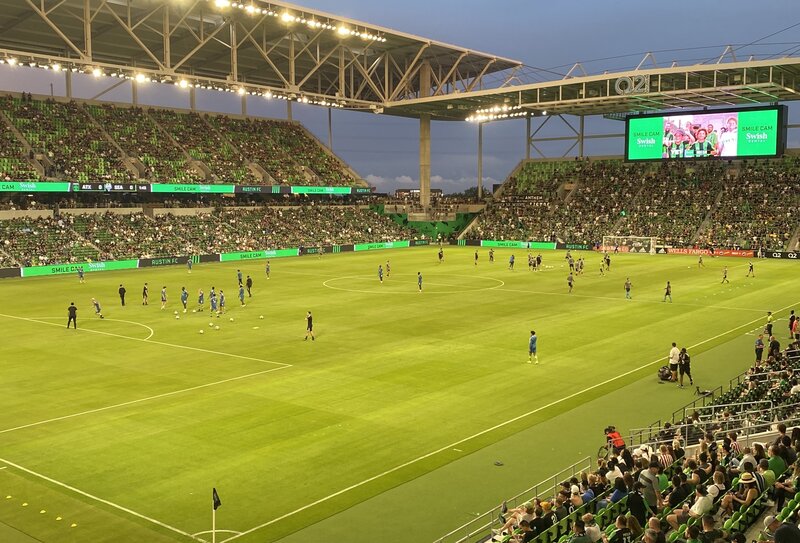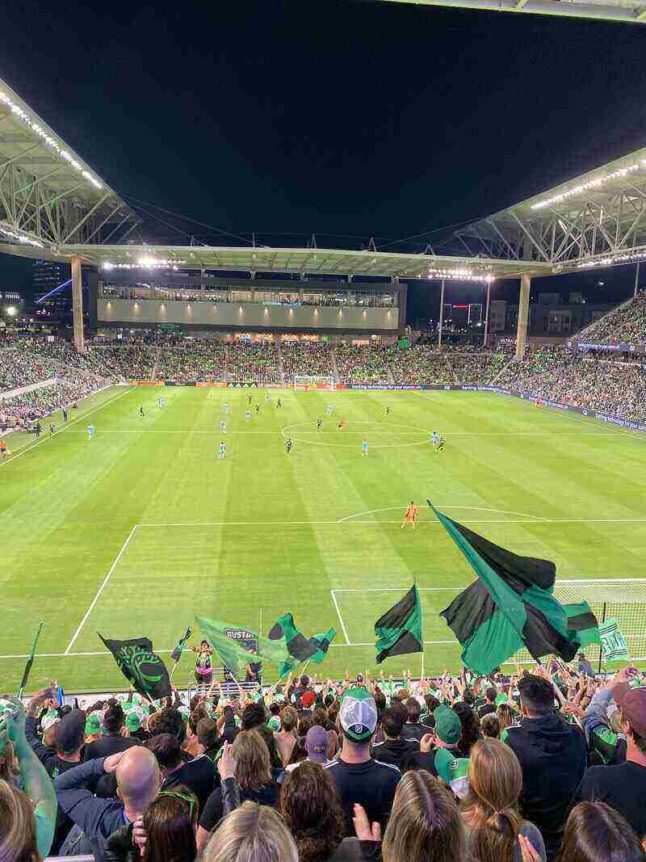
Austin is smack dab in the middle of Texas, so why does its major league soccer team play on seashore paspalum grass?
Let me explain…
The one thing we all know about grass is that it is green. At least, it’s supposed to be green.
Mix in a little heat – well, maybe a lot of heat – and being green becomes problematic. Science tells us that when the ground temperature gets between 75-80 degrees, grass stops growing.
Heat Turns Grass From Green to Brown
Just think about it. Your lawn grows like crazy in the spring and early summer, but when the temperature spikes, the less mowing is needed. When that happens, the green turns to brown. You battle that by increasing the amount of water your lawn gets. One of the byproducts of that water is lowering the ground temperature.
Ground temperatures, while regulated by air temperatures, don’t parallel the air temp. In general, it takes a 100-degree day to get the ground temperature up to 75 degrees or higher.
So, if an American sports team wants to play its summer games on a lush, green lawn, it’s easier to do it along the Pacific Coast, where the temperatures tend to be more moderate, than it is to do it under the blazing Texas sun.
Bucking the Fake Grass Trend in Texas
Pro and collegiate sports teams in Texas have known that since the world was young. Some have opted to install artificial surfaces, even if a majority of those playing on the fake stuff would rather be on grass.
And then there’s Austin FC, whose debut as a Major League Soccer expansion team came in April of 2021. Originally organized in 2018, Austin FC not only built its roster from the ground up, but did the same with its field, Q2 Stadium. Ground was broken on the facility in 2019, and part of that was choosing a playing surface.
Austin is no stranger to heat. On average, the temperature in Austin sits at 90 degrees or higher for 108 days a year, from early June through the middle of September. That’s going to be tough on any kind of grass.
To fight back, the club’s Senior Director of Grounds, Weston Appelfeller, went on the search for the ideal grass. He settled on the most heat-resistant grass he could find, seashore paspalum, produced by Platinum TE. Seashore paspalum won out over Tiff Tough Bermuda and Latitude 36 Bermuda.
Seashore Paspalum … in Austin?
Seashore paspalum is similar to those Bermuda grasses in both appearance and performance, and is particularly well adapted to a local like Austin, because while it tolerates heat particularly well, it doesn’t much like cold weather.
It’s used on a number of Texas golf courses, and Major League Baseball’s Houston Astros have played on it for about a decade at Minute Maid Park. It’s the current home turf for the Atlanta Braves, too. While the Braves play outdoors, the Astros have a retractable roof, and the seashore paspalum has held up well going in and out of shade.
That ability to grow both in sunlight and out of it particularly appealed to Austin FC. Mindful of the comfort of the 20,000-plus fans Q2 Stadium was built to hold, the facility has an enormous canopy over the top, blocking the sun and keeping the place as comfortable as possible.
Catering to Soccer Fans and the Soccer Field
The canopy does its job almost too well. Appelfeller and facility designer Jonathan Emmett and their crews built in sunlight-simulating equipment so that they can address areas of the pitch that can get insufficient sunlight. There are high-powered fans to keep air circulating. And there is a huge drainage system to whisk away the large amounts of water that can be the residue of the not-infrequent heavy summer rainstorms.
That being said, there is a bit of artificial turf laid along the sideline edges, areas likeliest to get less sun and maximum foot traffic.
‘Soccer Players Want to Play on Natural Grass’
Appelfeller got his start as a groundskeeper for the Boston Red Sox, then spent 10 years in Major League Soccer with the Philadelphia Union and Columbus Crew before coming to Austin for what he calls his “dream job.”
He brought all that experience into his search for his ideal grass, telling the Austin American-Statesman, “Soccer players, in general, want to play on natural grass more than anything.”
The seashore paspalum, while natural, isn’t native to Texas. It’s actually grown in Scottsdale, Arizona, just outside of Phoenix. Austin FC considers the grass valuable enough that the club keeps an extra ration on hand. If needed, the Scottsdale facility can provide more, and there’s a backup sod farm in Georgia that’s just a phone call away.

Austin FC is a Green Machine
That green is essential to Austin FC, too. The club has chosen bright green and black as the team’s primary colors. The Q2 seats are green. One of the team’s fan clubs is known as Los Verdes (The Green).
The St. Denis’s facility is built into a mostly outdoor 23-acre section of Austin’s Parmer Pond, a 300-acre site in the northern reaches of the city. It includes a green zone with a four-mile trail system, a manmade pond, setups for table tennis, a putting green and bocce ball courts as well as open lawn and sitting areas.
There is green all over the place – fully one-third of Austin FC’s 23 acres are given over to park-like green spaces beyond the greenery of the soccer pitches.
It isn’t closed off, either, so most of the green zone is accessible to the general population, whether Austin FC is in residence or not.
Going Green Costs Some Green, Too
The organization has paid a price for all that green space. Going park-like has cut into the amount of space that can be devoted to parking lots, so much so that from the outside, the place doesn’t look like the major sports venue that it is.
All that green, which starts with the soccer pitches, is how Austin FC wants to stress its Austin-ness.
“I think from day one, the ownership team understood that this is a city that really relates to its outdoor spaces,” Emmitt told The Austin Chronicle. “I mean the beauty of the outdoor spaces here but also the way [Austinites] live their lives.
“There’s a desire to be out there – the hike and bike trails, the parks – that’s almost synonymous with Austin culture.”
Hot stuff, right?
Main Photo Credit: Barry Galvin / LawnStarter